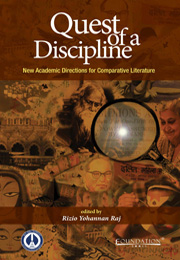Book contents
- Frontmatter
- Contents
- List of Contributors
- Acknowledgements
- Prologue to the “Quest'
- Introduction
- PART I Traditions and Manifestoes: Reflecting on Perspectives
- PART II The Quest Motif: Redefining the Scope of Comparative Literature
- 4 Beyond ‘Other Words’: The ‘Relevance’ of Translatology as Comparative Literature
- 5 Intertextual Lores and the Play of Language: Folklore/Orality in the Comparative Context of Literature
- 6 Towards a Comparative Performance Studies
- 7 Media Studies and the Academic Elite
- 8 Comparative Film Studies: The Culture Studies Turn in Comparative Literature
- 9 Finding Space in the Margin: Teaching Women's Literature in a Comparative Perspective
- PART III The Dynamics of Exchange: Genres, Areas and Disciplines
- PART IV India: A Curious Comparative Space
- Afterword: Comparative? Literature?
- Index
5 - Intertextual Lores and the Play of Language: Folklore/Orality in the Comparative Context of Literature
from PART II - The Quest Motif: Redefining the Scope of Comparative Literature
Published online by Cambridge University Press: 05 June 2012
- Frontmatter
- Contents
- List of Contributors
- Acknowledgements
- Prologue to the “Quest'
- Introduction
- PART I Traditions and Manifestoes: Reflecting on Perspectives
- PART II The Quest Motif: Redefining the Scope of Comparative Literature
- 4 Beyond ‘Other Words’: The ‘Relevance’ of Translatology as Comparative Literature
- 5 Intertextual Lores and the Play of Language: Folklore/Orality in the Comparative Context of Literature
- 6 Towards a Comparative Performance Studies
- 7 Media Studies and the Academic Elite
- 8 Comparative Film Studies: The Culture Studies Turn in Comparative Literature
- 9 Finding Space in the Margin: Teaching Women's Literature in a Comparative Perspective
- PART III The Dynamics of Exchange: Genres, Areas and Disciplines
- PART IV India: A Curious Comparative Space
- Afterword: Comparative? Literature?
- Index
Summary
INTRODUCTION
Many attempts have been made to define folklore. Let us describe it here as ‘the world of people's imagination’. It comprises almost every aspect of our cultural life, including oral literature, material culture, customs and rituals, festivals, drama and so forth. Often we talk of how folklore has influenced literature. For example, we say: ‘The Old Testament contains stories of folk heroes’ (Leach 819). Indeed, oral literature precedes written literature, logically as well as chronologically. Scholars like Bishop Percy and Chadwicks saw folk literature as the precursor of written literary forms. A study of oral and written literatures together may reveal parallel content and themes, styles, forms and structures. The focus of this paper thus is on the ‘lore’ rather than on ‘folk’.
Folklore in Literature: The Varied Functions
Archer Taylor makes three observations about the different relationships between folklore and literature: (i) Folklore is, in many cultures, indistinguishable from literature. (ii) Literature contains elements borrowed from folklore. (iii) Writers have imitated folklore. (Taylor 37).
The correlation between folklore and literature is obvious. The story of Rama in the Indian context is a part of the oral tradition even as it is a literary text composed primarily in Sanskrit and later in all the major Indian languages. The Kalevala in Finland is a compilation of folk songs, but at the same time it is considered a classical work in Finnish Literature.
Information
- Type
- Chapter
- Information
- Quest of a DisciplineNew Academic Directions for Comparative Literature, pp. 94 - 109Publisher: Foundation BooksPrint publication year: 2012
